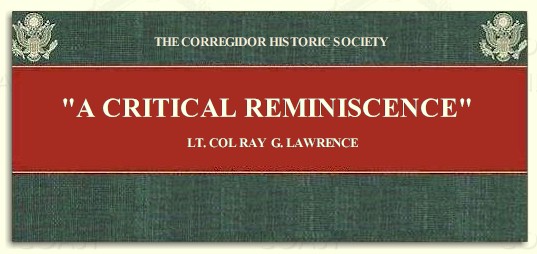|
|
Ray G.
Lawrence, Lt. Col.
1133 Western Meadows Road
Albuquerque 14, New Mexico |
| |
October 3, 1963 |
Dear Dr. Belote:
I was surprised to
hear from a historian after so long. I have read several accounts of the
surrender and prior siege but none to my knowledge have been too accurate.
I might say you are the first to question me although several senior
officers received a report from me after the surrender and then in P.O.W.
camp several persons were writing experiences, but to my knowledge the
latter all died in P.O.W. camp.
Yes, I commanded a
battery of 2 - 75mm model 1917 British made guns. In addition I had 2 -
37mm ex-caliber guns mounted in 50 cal. AA mounts, 2 - 50 cal. Machine
guns, 2 – 30 cal machine guns, 3 - 25 # aerial frag bombs, 8 – Browning
automatic rifles and 3,000 hand grenades. My command on 1 Jan. 1942
consisted of myself, a Phil. Army 3rd Lt. and 35 Philippine Scouts from
Btry "A" & "D" of the 92d CA (PS). I & my men were attached for command to
the 1st Bn 4th U.S. Marine Reg't, Commanded by Lt. Col. Beecher. My sector
started at the old Rifle Butt concrete wall approx 250 yards from the end
of the airstrip and continued to the tail end of the island. The location
was commonly known as East Pt., North Point was approx 1/2 mile to my
left.
As I obtained more
weapons, additional men were assigned. One platoon of the 4th U.S. Marines
joined me and took over the machine guns. Later, after Bataan fell, I
rec'd about 10 U.S. Army and Phil soldiers though they were tired and ill
with malaria. They had recovered by May 6th to perform. By then I had 82
men. The Phil Scouts manned the 75's and trained constantly to where they
could perform in the dark as well as in the daytime. Of course, I need
not tell of the ability of the Marines to handle the MG's & small arms.
They used to practice blindfolded clearing stoppages & getting the guns in
action. Within a week after Bataan fell I knew we were to be the target
for a landing as the Jap artillery attempted to zero in on our position &
the beach in front of us. We were shelled 5 times per day so close we
could almost set our watches. The Japs used 150mm & 240mm though they
never damaged our positions or caused casualties. They did hit 1 – 37mm
position twice but it was well revetted and so no damage. The first time
we were shelled my men were terrified as was I. It took me most of the
night to find everyone, they had dug in so deep. I then made it a
practice to hold gun drills & communication drills during all shelling.
It seemed to boost the morale and then they became sure that their
position was invulnerable. When the attack finally came, we were waiting
in our gun pits, every man on duty. The barrage immediately preceding
the initial landing was by far the worst. My own communications (field
phones) remained intact but my contact with Marine Hq. was severed; hence
I was not able to report, nor did I receive any orders subsequently.
I have always
thought the 1st wave hit us at about 9:30 P.M. just as the garage on the
beach lifted & moved further behind us and to the left on the airstrip.
We were all so busy I doubt if anyone looked at their watch, mine had
quit operating several weeks before. I had a 36" searchlight which was
operated by the scouts. I ordered it turned on when I had the motors
approaching the beach. It was knocked out by enemy small arms within 2-3
minutes but not before we got a good look at the craft about 100 yds from
the shore. We opened up with all guns & our tracers from the M.G.'s lit
up the beach. We hit many landing craft before they hit the beach, but
the M.G's made short work of those that landed. All guns were sighted
in to form interlocking bands of fire. That is all accept 1 – 50
cal MG. It had been moved 200 yds to my left the day before and I was
unable to protect it with flanking fire. It was captured shortly after
the 1st attack. We heard the Japs crying for mercy, telling us to cease
fire , they were Filipinos. Ater we had fired approx 1 hr. & we were
cleaning out the pits of empty shells, we heard more motors, the second
attack. By then the stars were bright and possibly the moon, coming up, I
don't remember, but we opened up when the craft were approx 500 yds out &
did a better job on them. I doubt if any reached the shore. I'm sure we
sunk at least a dozen offshore. This was a larger force, I believe, since
we fired more rounds.
|


